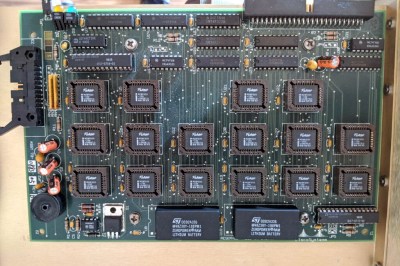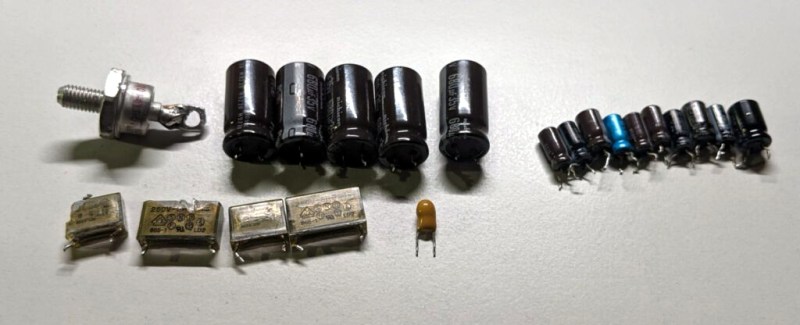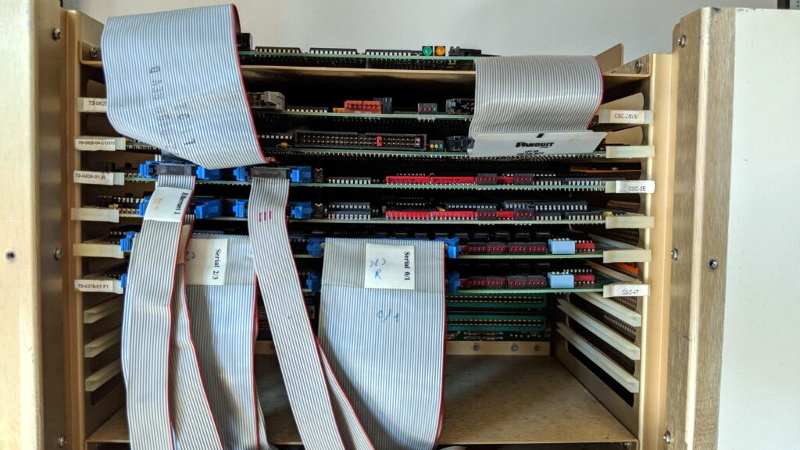It would be fair to say that the Internet as we know it runs on Cisco hardware. While you might never see the devices first-hand, there’s an excellent chance that every web-bound packet leaving your computer or smartphone will spend at least a few milliseconds of its life traveling through hardware built by the San Jose, California based company. But of course, even a telecommunications giant like Cisco had to start somewhere.
Cisco’s first commercial router, the Advanced Gateway Server (AGS), was released in 1986 and helped put the company (and the Internet) on the path towards unfathomable success. [Andreas Semmelmann] had wanted to add one of these microwave-sized machines to his collection for some time, so when an AGS+ popped up in the local classifieds he didn’t hesitate to make the hour drive to go pick it up. But like many pieces of vintage computing equipment, it needed a little help getting back on its feet.

Since he had to take the router apart anyway to diagnose what ailed it, [Andreas] decided to take photographs along the way and document this piece of Internet history. He walks the reader through the massive processor, Ethernet, and serial cards that are housed in the unit’s rack-like enclosure. We appreciate him taking the scenic route, as it gives us a great look inside what would have been state-of-the-art telecommunications gear when this version of the AGS hit the market in 1989.
The walk-through is full of interesting details that make us appreciate just how far things have come in the last 32 years. Imagine yanking the EPROMs out of the board and firing up the UV eraser each time you needed to update your router’s firmware. Or needing a special adapter to convert the AUI-15 connectors on the back panel to the now ubiquitous RJ45 jack.
After this stroll down memory lane, [Andreas] gets to the actual repair work. It likely won’t surprise the regular Hackaday reader to find that the power supply wasn’t operating to spec, and that some aged capacitors and a shorted rectifier diode needed to be replaced to put it back on an even keel. But even with the PSU repaired, the router failed to start. The console output indicated the software was crashing, but hardware diagnostics showed no obvious faults.

With some part swapping, firmware flashing, and even a bit of assistance from Cisco luminary [Phillip Remaker], the issue was eventually identified as a faulty environmental monitoring (ENVM) card installed in the AGS+. As luck would have it the ENVM capability isn’t required to boot the router, so [Andreas] was able to just disconnect the card and continue on with his exploration of the hardware that helped build the Internet as we know it.
Considering its age, this piece of 1980s Cisco gear ended up being in relatively good shape. But that’s not always the case. Over the years we’ve found ourselves in awe of the incredible amount of time, effort, and skill, it takes to restore some of these classic machines. We have great respect for the dedicated individuals who are willing to take on the challenge of keeping these pieces of history up and running for future generations to marvel at.
[Thanks to Bob for the tip.]
















I’m not convinced the opening sentence is a truth any more. I think theres a lot more HW provider diversification now.
I agree with this, lots of different vendors. Even weird ‘white boxes’ (hardware vendor X running Cisco or Juniper code, for example.
extreme networks, juniper, emc(dell?), HPE. i see them in the DC.
Well, the opening sentence is more saying that a lot of packages likely goes through a cisco product somewhere along the chain of jumps.
Though, to be fair, this is likely true of Ericsson switch gear as well as other providers like Juniper, Dell/EMC, Netgear, Huawei etc.
After all, a package can jump over many switches on its way to its destination, so the odds that any given switch vendor is used is having larger and larger odds the further one goes, at least as far as the more enterprise/DC level stuff goes.
https://en.wikipedia.org/wiki/List_of_Cisco_products
They are mostly in enterprise and small business. They also have cable internet stuff.
Internet backbone runs on Carrier grade with “five nines” (99.999% availability). You’ll find other names there.
“They also have cable internet stuff.”
In name yes. Given that Cisco bought Linksys I wonder how much of that consumer kind of stuff has any relation to “classic Cisco” and how much it’s just the continuation of Linksys under Cisco’s name and corporate overlords.
Nice to see leeching not even very good cisco kicked out
From the few quick searches I just did, everyone seems to agree Cisco is still the market leader. But you’re right that it’s a fairly diversified field, and other companies like Huawei are giving them a run for their money these days.
I work for a large regional ISP (cable and EPON FTTH). Not all ISPs are alike, but we run 100% Cisco gear for layer 3, and quite a bit of Cisco gear for other layers. We have a lot of Cisco ASR 9k series routers and Nexus series switches in our headends, and use 9ks in carrier hotels for peering. Like a lot of other ISPs, we funnel these into Infinera gear to link the sites together. On the access side, Cisco CBR8 CMTSes to run cable modems, which are pretty standard for any cable ISP that provides gigabit speeds via DOCSIS 3.1.
Cable ISPs that are still on DOCSIS 3.0 speeds may be running Cisco 10k CMTSes or older Motorola/Arris CMTSes. A lot of newer GPON or EPON FTTH ISPs run Nokia OLTs to light their PON network, but still may use Cisco gear in the core of their network and/or peering to the greater internet.
I agree that odds are though, especially if you have cable internet, that you’re running through at least one Cisco box on the vast majority of your routes on the internet.
Another service provider engineer checking in here. We’re in 41 markets in the southern US. The only thing we use Cisco for is CMTSes (cBR-8), although we’ve been slowly replacing them with Arris CMTSes (E6000). All of our other edge, core, aggregation / distribution and access layer stuff is Juniper (aside from our GPON, which is a combination of Adtran and Calix). Most other service providers I’ve worked at or with were Juniper shops as well. That’s not to say that I don’t ever see Cisco, just that in my personal experience their market share has slipped significantly. Personally I hate working on Cisco gear and have avoided taking jobs at Cisco shops. They make decent hardware (if not severely overpriced) but Cisco’s network OSes are garbage compared to Junos.
I have an ACS (AGS+ Terminal server) and an AT&T Brouter (CGS I think). I can’t recall if it’s running 9.x or 10.x.
Old equipment can be a challenge.
https://youtu.be/upTgM_S5rAQ
“Imagine yanking the EPROMs out of the board and firing up the UV eraser each time you needed to update your router’s firmware”
Around that time I was doing embedded development for living. I saw many times such worflow in action, and even burned a few EPROMs myself. I was taking an EPROM from a box with blanks, put it into the programmer, and waited several minutes until it finished its work. Chip pulled out of the socket was going to the eraser, and EPROMs which failed during programming were landing on a pile of deffective chips.
However, majority of my work was done using an EPROM emulator. It was a box connecting to conmputer’s parallel port on one end, and having a short ribbon cable with an emulation plug going into the eprom socket on the other side.
It was a miracle. Cycle time was cut from minutes to seconds.
What is interesting, what convinced the company to invest in the tool was me bringing my home-made emulator and demonstrating how much difference it makes. In a few days I found on the desk a box with a professionally made emulator.
When I was first working in networking (1989) I installed, configured upgrade and managed the board order. Upgrading these router required EPROM swaps (8 at a time).
I visited some really far away places (Bauxite AK, guess which company).
BTW, the developers of these Cisco boxes used gdb over the network and net boot for their testing.
Customers were also welcome to net boot new firmware. The steps needed to handle the “new version + old version don’t fit in RAM at the same time” was “entertaining.”
Things were more fun if you needed to upgrade the firmware on one of the bitslice-based interface controller cards. IIRC, that was 13 or so “narrow” high-speed EPROM chips. (fortunately, this was not required very often!)
> Imagine yanking the EPROMs out of the board and firing up the UV eraser each time you needed to update
Ahhh yes. the sweet, sweet glow of the mercury lamp. That, and the sickly hue of the cheap fluorescent tubes in every single beige development lab were pretty the color palate of my engineering youth.
Also, conveniently, the sickly hue of the cheap fluorescent tubes could sometimes do the erasing for you, one bit at a time, if you weren’t careful about covering your little quartz windows.
Good times, finding *those* bugs.
> Imagine yanking the EPROMs….
Interesting statement here when Flash chips (no windows) are shown – just sayin :)
Development was done with windowed chips. And even the so called One-Time-Programmable chips were reusable if you had an access to a sufficiently strong x-ray source :)
The AGS+ Flash card was a later development.. I think support for it was added somewhere around software version 9.0. (…and it wasn’t called IOS back then.) When I started my career, my employer had a number of Cisco boxes (AGS+, ACS, MGS) that were running version 7.0 or 7.1 on EPROM, later we moved to 8.1 and it seemed like we ran 8.3(3) forever but it probably was only 18 months, LOL. Funny, we never erased EPROMS, we just received new ones under our SmartNET agreement and threw the old ones in a parts cabinet. Those old routers never got upgraded to flash – they got upgraded to 7000 and 4000 series boxes. (not to be confused with Nexus 7K or 4000 ISR either!)
The flash card shown in the photo was a much later development than the original cisco routers. In fact, cisco was one of the companies who ended up royally screwed when Intel blew their flash memory commercialization (all sorts of product designs “ready” for flash, no flash chips actually available. :-( )
Disgusting workship of cisco
FYI: The film caps (safety caps) and the one tantalum capacitor do not suffer from drying out like the electrolytic caps.
No point of recapping those.
The filter (“safety”) caps, as the article points out, are very prone to shoring out and making noxious clouds of magic black smoke. Though usually harmlessly to the device
Do you think the NSA backdoor has been put in place there already?
Is this one of those infamous 7-bit routers that would destroy MacBinary archives and any other file passing through that wasn’t ASCII text, which required all 8 bits of every byte to go through un-molested? The early days of the internet and WWW had those “potholes” which is why Binhex and other 7 bit methods of encoding binary files to ASCII text were developed.
It was common for Macintosh software sites to have three small test files to download and attempt to extract. One Stuffit archive, one MacBinary encode of the Stuffit Archive, and one Binhex encode of it. They were small for people on metered connections. If the Stuffit archive survived then that saved the most data, while BinHex was the last resort, due to it having to be larger than the other two.
I wonder when the last of the 7-bit routers was taken offline?
No. Those would have been “terminal servers.” And even the early cisco terminal servers were 8bit transparent when correctly configured. (Telnet hosts… not so much. Sigh.)